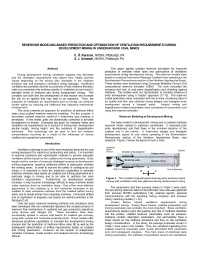Mining Publication: Reservoir Modeling-Based Prediction and Optimization of Ventilation Requirements During Development Mining in Underground Coal Mines
Original creation date: February 2008
During development mining, ventilation capacity may decrease and the ventilation requirements may depart from initially planned values depending on the mining rate, increases in the methane emission rate, and changes in ventilation airway leakages. Insufficient ventilation air quantities and the occurrences of high methane liberation rates can overwhelm the existing quantity of ventilation air and result in elevated levels of methane gas during development mining. This condition can both limit the development of that section and increase the risk for an ignition that may lead to an explosion. Thus, the prediction of ventilation air requirements prior to mining can enhance worker safety by reducing the likelihood that explosive methane-air mixtures form. This study presents an approach for prediction of methane inflow rates using coalbed methane reservoir modeling. For this purpose, a two-phase coalbed reservoir model of a three-entry type roadway is developed. In the model, grids are dynamically controlled to simulate development of entries. Examples are given for methane inflow and ventilation air requirements as a function of mining rate, development section length, mining height, and the existence of degasification boreholes. This technology can be used to limit the methane concentrations occurring as a result of the influences of various coalbed and operational parameters.
Authors: CÖ Karacan, SJ Schatzel
Conference Paper - February 2008
NIOSHTIC2 Number: 20033622
2008 SME Annual Meeting and Exhibit, February 24-27, Salt Lake City, Utah, preprint 08-010. Littleton, CO: Society for Mining, Metallurgy, and Exploration, Inc., 2008; :1-5
See Also
- A CART Technique to Adjust Production from Longwall Coal Operations under Ventilation Constraints
- Development and Application of Reservoir Models and Artificial Neural Networks for Optimizing Ventilation Air Requirements in Development Mining of Coal Seams
- Evaluation of the Relative Importance of Coalbed Reservoir Parameters for Prediction of Methane Inflow Rates During Mining of Longwall Development Entries
- Guidelines for the Control and Monitoring of Methane Gas on Continuous Mining Operations
- MCP - Methane Control and Prediction - 2.0
- Modeling and Prediction of Ventilation Methane Emissions of U.S. Longwall Mines Using Supervised Artificial Neural Networks
- Prediction of Longwall Methane Emissions and the Associated Consequences of Increasing Longwall Face Lengths: A Case Study in the Pittsburgh Coalbed
- Problems Facing Coal Mining and Gas Production in the Hartshorne Coalbeds of the Western Arkoma Basin, OK
- Remote Methane Sensors
- Reservoir Rock Properties of Coal Measure Strata of the Lower Monongahela Group, Greene County (Southwestern Pennsylvania), from Methane Control and Production Perspectives
- Page last reviewed: 9/21/2012
- Page last updated: 9/21/2012
- Content source: National Institute for Occupational Safety and Health, Mining Program


 ShareCompartir
ShareCompartir
